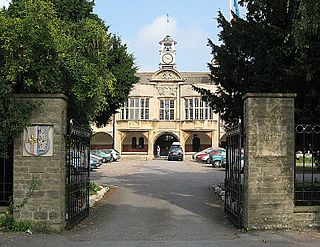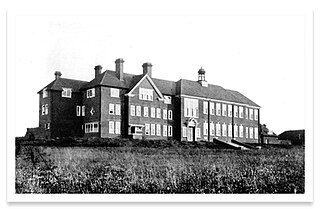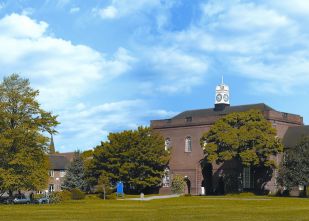A grammar school is one of several different types of school in the history of education in the United Kingdom and other English-speaking countries, originally a school teaching Latin, but more recently an academically oriented secondary school, differentiated in recent years from less academic secondary modern schools. The main difference is that a grammar school may select pupils based on academic achievement whereas a secondary modern may not.

Priory School is a secondary school in Southsea, Hampshire, England. It is situated in the northern area of Southsea bordering Fratton, and lies close to Fratton railway station on the A2047. Stewart Vaughan is the Headteacher at the school. Priory school is an academy and part of the Bohunt Education Trust.
Abbot Beyne School is a comprehensive school in Burton upon Trent in east Staffordshire, England. It was created after the Burton Grammar School was phased out and initially educated the remaining pupils from Burton Grammar School and Burton Girls' High School who had been selected at the age of 11 as pupils likely to benefit from a highly academic education. It inhabited the Grammar School site but as a newly created comprehensive school, did not inherit its educational pedagogy.

Weymouth College is a further education college located in Weymouth, England. The college has over 4,000 students, studying on a wide range of practical and academic courses in many subjects. The college is part of The University of Plymouth Colleges network.

Sir Walter St John's was founded in 1700 for twenty boys of the village of Battersea. As the population and the English educational system changed, so did the school. The school was colloquially known as "Sinjuns" and was finally closed in 1986-7.
Dover Grammar School for Boys (DGSB) is a selective secondary school located in Dover, United Kingdom, whose origins can be traced back to the Education Act of 1902. Originally founded as the Dover County School for Boys and Girls with locations behind the Dover Town Hall and on Priory Hill, the co-educational arrangements were early on prohibited by the Kent Education Committee. Dover Grammar School for Boys now occupies a prominent position overlooking the town of Dover on Astor Avenue. Its sister school is located in Frith Road and known as the Dover Grammar School for Girls (DGSG).
Ormiston Denes Academy is a secondary school with academy status located in the northern outskirts of Lowestoft in the English county of Suffolk. It has around 1000 students aged 11 to 16.

Lincoln Christ's Hospital School is an English state secondary school with academy status located in Wragby Road in Lincoln. It was established in 1974, taking over the pupils and many of the staff of the older Lincoln Grammar School and Christ's Hospital Girls' High School, and two 20th-century secondary modern schools, St Giles's and Myle Cross.

Farnham Grammar School is now called Farnham College which is located in Farnham, Surrey, southern England.

Wallingford School is a secondary school with academy status located in the town of Wallingford, Oxfordshire, England. It was founded by Walter Bigg in 1659 in association with the Worshipful Company of Merchant Taylors, formally succeeding Wallingford Grammar School when it merged with Blackstone Secondary Modern in 1973.

Hele's School was a boys' grammar school, and latterly a comprehensive school, in the city of Exeter, Devon, England.
The Bemrose School is a foundation trust all-through school situated on Uttoxeter New Road, Derby, England, with an age range of pupils from 3 – 19. Opened as a boys' grammar school in 1930, it became a co-educational comprehensive school in 1975. It then became an all-through school with the addition of a primary phase in 2014.

The former Queen Elizabeth's Grammar School in Crediton, Devon, England was founded in 1547 by Edward VI and re-endowed and renamed in 1559 by Elizabeth I.

Hardenhuish School is a large mixed secondary school and sixth form in Chippenham, Wiltshire, England, for students aged 11 to 18. Together with Abbeyfield School and Sheldon School, it is one of three secondary schools in the town with academy status. The school's headteacher is Lisa Percy.

A direct grant grammar school was a type of selective secondary school in the United Kingdom that existed between 1945 and 1976. One quarter of the places in these schools were directly funded by central government, while the remainder attracted fees, some paid by a Local Education Authority and some by the pupils' parents or guardians. On average, the schools received just over half of their income from the state.
Magnus Church of England Academy often abbreviated as 'Magnus', is a British secondary school located in the market town of Newark-on-Trent, in Nottinghamshire, England. It was founded as a grammar school by the 16th century English diplomat and cleric, Thomas Magnus; the original school building, located in Appletongate by the church, is now a small museum.

Portsmouth College is a sixth form college on Tangier Road, Baffins, in the city of Portsmouth, England.
Tottenham Grammar School (TGS) was a renowned grammar school in North London, with local football connections.
The Peterborough County Grammar School for Girls was an all-female grammar school in Peterborough, Cambridgeshire, England.
Kilburn Grammar School was an English grammar school which opened in 1898 in Kilburn, north-west London. The school ceased to exist in 1967.












